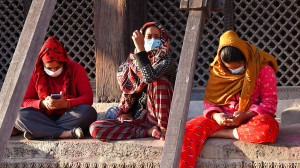Opinion
Chasing the dream
Most non-Western societies lack a multi-pronged approach to question the past and bring in a new future
Pramod Mishra
The celebration of black life and history began in the United States with the birthday of Dr. Martin Luther King, Jr, on January 15 and will continue through February when Abraham Lincoln’s and Frederick Douglass’s birthdays occur. As in other years, this past Monday was a holiday in most offices and institutions, and many television channels and radio stations played audio-visual narratives of Dr. King’s life and works, reminding the American public of the struggles, trials and triumphs of the past in overcoming prejudice and discrimination.
But unlike other years in the recent past, this year’s celebration is not only punctuated by the Democratic and Republican primary debates but is also overshadowed by the twin events of police shootings of black youths in Ferguson, Missouri; Charleston, South Carolina; Baltimore, Maryland and Chicago, Illinois and protests by blacks and whites all over the country against police brutality and racism. In South Carolina itself, where Nikki Haley (Nimrata Nikki Randhawa), an Indian American, is the governor, a white young man gunned down nine black people in a 200-year-old black church in June 2015 in order to—as he confessed later—ignite a race war. Following this hate crime, the state removed the Confederate flag, a symbol of Southern racial pride, from the premises of the State House by a two-thirds majority.
Campus protests
These incidents sent ripples across university campuses as well. Black and white students on more than seventy college campuses, including Yale, Princeton, and University of Missouri organised protests and hunger strikes to end ‘systemic and structural racism on campus’. Students demanded and got the resignation of both the President and the Chancellor of the University of Missouri. Princeton students occupied the University President’s office, demanding the removal of the 28th US President Woodrow Wilson’s name from campus buildings, where he is honoured by having a school and a residential college named after him.
Students claimed that Wilson is a symbol of the university’s long history of excluding all but white Christian men. Wilson opposed the efforts of civil rights leaders and advocated segregation. Students and the Princeton administration reached an agreement to discuss Wilson’s legacy, which had long gone without public scrutiny. Protesters also demanded cultural competency training for the university’s faculty and staff, a cultural space dedicated for black students and more courses on the history of marginalised peoples.
A similar controversy erupted on the Yale University campus. This time it was about Halloween costumes. On October 28, the Yale Dean and Yale’s Intercultural Affairs Committee sent an email to students asking them to be “safe and thoughtful” about their Halloween costumes. The email said, “Halloween is also unfortunately a time when the normal thoughtfulness and sensitivity of most Yale students can sometimes be forgotten and some poor decisions can be made including wearing feathered headdresses, turbans, wearing ‘war paint’ or modifying skin tone or wearing blackface or redface. These same issues and examples of cultural appropriation and/or misrepresentation are increasingly surfacing with representations of Asians and Latinos.” In response to this email, the associate master of the residential Silliman College wrote a counter email, saying, “As a former preschool teacher, for example, it is hard for me to give credence to a claim that there is something objectionably ‘appropriative’ about a blond-haired child’s wanting to be Mulan for a day... I wonder what is the statute of limitations on dreaming of dressing as Tiana the Frog Princess if you aren’t a black girl from New Orleans? Is it ok if you are eight, but not 18?” In her email, she wondered about the state of free speech on college campus. She wrote, “Is there no room anymore for a child or young person to be a little bit obnoxious... a little bit inappropriate or provocative or, yes, offensive? American universities were once a safe space not only for maturation but also for a certain regressive, or even transgressive, experience; increasingly, it seems, they have become places of censure and prohibition.” And when two coloured girls were turned away from a fraternity party allegedly because of the colour of their skin, the whole controversy turned into a debate between free speech vs. hateful behaviour.
The response
These controversies and protests have drawn attention to race and justice issues that had not occurred in a while in the United States. Students’ demands include more faculty of colour, more courses on diverse groups, more funding for minority student organisations and more scholarships for poor students. The university administrations have also responded. For example, Brown University announced on November 20 a $100 million initiative aimed at increasing racial inclusivity on campus. Yale’s president announced that he would reconsider Calhoun College’s name (named after a South Carolina senator who defended his race privilege in the US Congress).
These campus protests reflect the inequity still prevalent in American society, but the point is that the university administrations have quickly taken steps to address the issue and open a debate about it before it gets out of hand. Even in Chicago—where recently a video was released by court order of a shooting of a black teenager by a white police officer in which the officer shot the boy 16 times—as soon as the protests occurred, the mayor dismissed the police chief, ordered an internal inquiry and welcomed an inquiry by the US Justice Department. This administrative and political resilience helps society move forward and continually renew itself, leaving behind the regressive mindset of the past and ushering in a fresh future. When people from the bottom speak, leaders from the top listen, change or quit.
What most non-Western societies like Nepal lack is this multi-pronged approach to interrogate the past and bring in a new future. Why do even many educated people from these societies think, speak and behave like Miss Emily of William Faulkner’s story, ‘A Rose for Emily’, in which Emily stubbornly refuses to let go of the past and suffer from necrophilia? Why is there this gap in the functioning of the Western and non-Western societies? Why are ideas and institutions not constantly and actively examined and renewed in the latter? These are important questions for us to ponder.




 12.12°C Kathmandu
12.12°C Kathmandu








%20(1).jpg&w=300&height=200)

